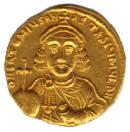Roman Emperors Dir Anastasius Ii
An Online Encyclopedia of Roman Emperors
Anastasius II ( A.D.713-715)
Bronwen Neil
 (c) 2000 Chris
Connell
(c) 2000 Chris
Connell
Relying on G. Sumner's reconstruction of the order of events in this troubled period, we can date Artemius' acclamation as emperor at Constantinople to the day of Pentecost June 4, 713, i.e. the day after the blinding of his predecessor Philippicus, under whom he had been first secretary (protoasecretis). Grierson places the acclamation on 26 May of the following year. In the following fortnight the two who had conspired together to bring about the blinding of Philippicus, Theodorus Myaces and Georgius Bouraphus, Count of the Opsician theme, were also blinded and exiled. Having thus removed these possible rivals to imperial power, Anastasius turned his attention to the continuing Arab threat in Galatia. He was involved in elaborate fortification of Constantinople against the possibility of Arab invasion - amassing grain supplies, restoring the land and sea walls and building siege weapons -, and undertook negotiations for peace with Caliph Walid. It was probably during the second year of his rule, on 11 August 714 (or possibly 715), that Germanus, Metropolitan of Cyzicus, was elected Patriarch of Constantinople. Germanus replaced John VI, who had supported Philippicus' monothelite policy. Anastasius reversed this policy and recognised the Sixth Ecumenical Council. In the spring of 715, Anastasius sent a fleet to Rhodes against the Saracen fleet which was sailing from Alexandria to Phoenix. However, while stationed at Rhodes, rebels among the Byzantine naval force - the Opsician troops - revolted against Anastasius, taking up as imperial candidate a certain Theodosius. The Opsicians sailed back to Constantinople and held the city under siege for six months. Anastasius consequently withdrew to Nicaea where he was met by the patriarch Germanus, who persuaded him to surrender in 715 or 716. Thereupon he abdicated, became a monk and was exiled to Thessalonike, having ruled for just over two years. In 719 he returned from exile with the support of the Bulgarian khan Tervel who contributed gold and troops to his march against Leo III. However, he was surrendered to Leo by the Bulgars, and put to death (by beheading) as a plotter against Leo on June 1, 719. Anastasius' wife Irene had him buried in Constantinople in the mausoleum of Justinian in the Church of the Holy Apostles. She was later buried in the same mausoleum.
Bibliography
P. Grierson, 'The Tombs and Obits of the Byzantine Emperors (337-1042)', Dumbarton Oaks Papers 16 (1962). Appendix: Analysis of Sections II and III of the Necrologium, 52.
Oxford Dictionary of Byzantium: s.v. "Anastasios II" (Paul Hollingsworth)
G. Sumner, 'Philippicus, Anastasius II and Theodosius III', Greek, Roman and Byzantine Studies17 (1976), 287-294; here 289-291.
Copyright (C), Bronwen Neil. This file may be copied on the condition that the entire contents, including the header and this copyright notice, remain intact.
For more detailed geographical information, please use the DIR/ORBAntique and Medieval Atlas below. Click on the appropriate part of the map below to access large area maps.

 DIR Atlas
DIR Atlas